
After writing about menswear evangelism and thinking about the methods the space implements to get other people to start caring about clothes, it was only a matter of time before I started thinking about capsule wardrobes. As many of you know, I’m not a huge fan of them. I find them overly pragmatic and detached from emotional connection, which you can see in this definition below taken from this post on r/MaleFashionAdvice ten years ago, a capsule wardrobe is:
a wardrobe that is designed to minimize the amount of clothes you wear while simultaneously maximizing the number of outfits you can wear with them. With the perfect capsule wardrobe, you should be able to get dressed in the dark and everything should look coordinated when you turn on the lights. Depending on your needs, it could consist of as few as 7 pieces or so (if you are EXTREME! I am not). At a minimum, you need a shirt, a sweater, some pants, a jacket, and some shoes for a total of 5 pieces. As you know, this configuration is very limiting. You have to do laundry all the time and What on Earth do you wear while you are washing your one pair of pants?!! 😀 The capsule wardrobe I will show is more reasonable and has 19 active pieces with 5 on-season pieces and 5 off-season pieces. This means that the wardrobe will have 24 pieces active at any point in the year.
As the quote shows, a capsule wardrobe is really meant to take any fun, intentional thought guesswork out of getting dressed so you can just throw anything on (without even looking) and walk out the door, with the implication that you are going to automatically be stylish in your everyday life…provided you follow the list.
This makes the capsule wardrobe simultaneously hyper-specialized in purpose while being agnostic in identity, resulting in something that is static and doesn’t provide room to grow or expand. This could be because most capsule wardrobes look like a cohesive and specific aesthetic, being a mix of Americana and minimalism. Terms like the “MFA Uniform” and “The Basic Bastard” are thrown around when you make a look that follows the general ideas of a capsule wardrobe, though this is only if you are being perceived online (though I’ve heard it IRL a few times).
The look and its accompanying philosophy are extremely popular. Following such lists help you look “good” (but not too bold because standing out is to be avoided) all while involving the least amount of effort. I certainly get the appeal. Fashion can seem like it’s an esoteric thing that regular people can’t get into, which is why people rather min-max their clothes. It’s enough to get by for work and hanging out with friends/dating and that’s what most people want from their clothes.
The whole idea of a capsule wardrobe is meant to be pragmatic by design. It’s meant to be the first step into intentional dressing, despite the fact that it also purports itself to be self-sustaining. In other words, the capsule wardrobe is the first and only step for guys to look “good” (of which good is rooted in the external, traditional social benefit framework). And that’s mainly why I have a problem with its philosophy.

The concept’s root in pragmatism ultimately comes off more like a “way to not be naked” instead of a true starting point for a personal style journey. Granted, not everyone wants clothing to be a hobby but I do think people should feel connected and excited to wear their clothes. Clothing is an avenue for expression and that doesn’t happen when you just want them to cover your body and are meant to be put together in the dark without any intention.
It doesn’t help that everyone’s contexts have changed over the past few years. People can wear almost anything (within reason) to work, which makes many recommended clothing choices (like the ones in a capsule wardrobe) seem arbitrary. It just so happens that a min-max capsule wardrobe just looks like a list of items for a stereotypical software engineer/consultant bizcaz cosplay instead of serving as the building blocks for an intentional approach to clothing. And if you, like most people who wear clothes, do eventually get to expand your taste (like a cool designer piece, a quirky piece of vintage, or even changing up the silhouette), those basic, capsule wardrobes inherently resist the introduction of those pieces. The capsule wardrobe locks you into its own self-contained aesthetic.
In other words, if you don’t see yourself looking like the MFA uniform to everything you do for a long time, it doesn’t really have much application to your life. I can see this quality turning people off from making any sort of intentional effort with their clothes, since they just aren’t connected with the POV that a typical capsule wardrobe presents them. The Perception of Effort involved in creating a personally exciting wardrobe can be hard to get over.
To be fair, this could be said about a lot of fashion genres. After all, a lot of looks (not just menswear) can be boiled down to a few core pieces that may not go with elements from other genres. The difference is that this level of curation comes later rather than at the beginning. Your wardrobe should not only serve as a baseline for your personalal expression but can also be a launching point to new things. That way it can feel like you’re adding to your canon instead of completely starting from scratch every time you want to try something new or different.
And that being said, I don’t think that the stereotypical capsule wardrobes are inherently bad. I do think that it can be helpful to introduce the ideas of menswear to newcomers. It is good to dress in a way that is “nice”and the basics of classic menswear certainly do that. My issue could just be with the approach. A capsule and basic wardrobe are building blocks, not end-all capstones. After all, a newbie to music doesn’t just listen to The Beatles; they eventually go out and explore, building on their initial taste.
Derek had a great breakthrough with his Springboard Wardrobe, which simultaneously covers the basics for most occasions while keeping yourself often to upgrading and experimentation. But I want to offer my own alternative approach, one that focuses more on what you personally like to wear rather than a list of recommendations: the foundational wardrobe.
The foundational wardrobe is an intentionally vague concept that I came up with after many conversations with friends who wanted to learn how to become more intentional with their style. I’ve found that this makes for a more engaged relationship with clothes, which I always think is the best possible result (even if it doesn’t lead them to doing classic menswear).
As you’ll see, this whole thing is built on expression and emotional connection, which leads you to introspect and make your own list of basics that you think you need to look the way you want. This is not a list of necessary items, but rather a foundational philosophy that is meant to guide you to find what comprises the core pieces that make you look like you. You might be surprised that they might not even be what people consider to be essentials…but they may be extremely important to your look.
Now the first step in creating a foundational wardrobe lies in determining your desired silhouette and vibe. Physical contour is a very expressive part of clothing, which is why it’s extremely important to figure this out. Do you want your clothes (any of them) to be slouchy? Or do you want some structure? Are you intending to look buttoned up or relaxed and easygoing? I think that a silhouette is an iconic part of someone’s personal style as it can be applied to all parts of their wardrobe. And the good thing is that you can usually find a garment in the fit you want. Suits, jeans, and shirts aren’t all slim or wide anymore, which is why you should decide the fit you want first.
Obviously, people usually end up liking a myriad of silhouettes and allocate them to different garments.. Suits could be structured, casual pants could be wide, boots could be sharp, and sneakers could be chunky. But that’s why it’s good to think about silhouette first. There is no right answer, but there is a correct choice for what you want to look like. For example, I’m pretty well known for my wide fit across all my pieces like my slouchy cotton suits, big gurkha shorts, and delightfully dumpy rugged pants. However, I do keep a bit of shape in some of my jackets and I’ve been known to enjoy the flare, especially when going out.
That’s why the following step is determining your formality or rather, the occasions that . Do you want to mainly wear a suit or can you get away with a blazer or chore coat? Do your pants need to be hardwearing as well (leading to chinos or jeans) or is it fine to wear wool trousers? This naturally leads into thinking about the details you want to have in those garments, like lapels, pockets, or even color.
If you’ve determined that your slouchy silhouette can be used in your suits, you may lean into it more by making it in an ivy-sack configuration and made of a soft cotton. You may have decided that your suits need to be on the formal side, which then requires peak lapels and super 120s wool fabrics. Or maybe you know you can get away with an Engineered Garments suit made from nylon and features a bazillion pockets because you’re a photographer.
As you can see, this exercise is meant to turn your desired POV into a core list of expressive details that you want to achieve from individual garments and overall outfits. Everyone will find that they have some sort of foundation that they use to create outfits (and their holistic style), but the hope is that it will be more personal. Most pieces may not exactly line up with the items recommended from typical capsule wardrobes.
For example, Spencer works with a rather minimal mix of jeans, workshirts, military jackets, and occasional sportcoats as his foundation. His style works for everything in his life, from job interviews and reporting to hanging out with friends. Marco’s foundation isn’t really in specific pieces but in general expression: his foundational wardrobe relies on big pants, chore jackets, and mesh shirts all in a variety of colors and patterns. You might say that his baseline lies in silhouette, color, and slightly funky designs that are rooted in a vague sense of menswear.
I think I’m quite similar to Marco, where my foundational style is based on silhouette and classic menswear details, expressed mainly through variations of ivy and Esquire Man. If I had to boil it down further, perhaps a full-legged grey trouser, a black beret, a blue striped spearpoint, and a brown DB suit are specific items that comprise the foundations of my style. I generally dislike hate being this specific and prescriptive but it’s true that they work with nearly everything I do in my regular life. In that sense, those collections of items really do become a capsule…though you might say that my wardrobe is full of multiple capsules!
The more I meet other people, the more I see that other enthusiasts have their own foundations. Some of them never bought stereotypical basics like a white OCBD or a black lace-up oxford, skipping the Basic Bastard look entirely. They had the self-awareness to know that certain things just didn’t fit into their lives; it’s important to note that this didn’t stop them from getting dressed and being incredibly stylish people. Some of them started to wear what we’d consider to be basics later in their lives, but that was because their POV expanded to doing those looks intentionally, rather than starting out there because they had to.
We all have specific items that may not be considered a basic but are indeed foundational (and necessary) to many of our regular looks with ease and repetition. It even makes it easy for us to experiment and build on what we have. That’s because our foundational wardrobes are rooted in taste and personal connections, which means that we are free to build on them as we see fit.

The hope when you have a foundational wardrobe rooted in taste, lifestyle, and personal expression, you should start to become aware of our expressive themes. The wardrobe is still a singular thing, but like a landscape, there are multiple avenues of expression from this one thing. I think that this “thing” is discernable.
This throughline is what makes trying new things natural and cohesive instead of foreign and scary. For example, this could be like discerning the pipeline from collecting milsurp and workwear to adopting practicality-inspired garments from Engineered Garments or 18East (which is what MJ did). For others, it could be about leaning into drama and silhouette, like how I related slouchy menswear to Safincore. In other words, while a foundational wardrobe can certainly play into the formal requirements of our life, it is not inherently rooted in specific dress codes.
In all cases, our foundations made it easy for us to experiment. It wasn’t because our styles were basic (though menswear isn’t as crazy as being into Rick as a baseline), but because our wardrobes were built on emotional cohesion. Nothing is meant to be replaced or upgraded nor is it necessary to buy new things (and we don’t), but there is an ease to which “unconventional” garments (or style moves) can be added to our canon. Perhaps this is why my friends and I have more of a “fashion” mindset compared to other classic menswear guys, seeing as how often we add fun stuff to our admittedly standard style.
Following our emotional foundations leads to us to practice forced versatility, where a garment’s aesthetic versatility comes from us making it work because we like it. We are freed from thinking about garments only through their historical formality or conventional pairings; the only constraint becomes our imagination and willingness to make it work. For example, it just made sense for me to put my kimono coat with my black tie slippers or for MJ to pair his 18East cargos with a blazer. In other words, our capsule wardrobe is not meant to be bizcaz, so new items are not boxed only into what is acceptable for bizcaz.
This reminds me of Christian’s latest video. While his video is framed as “optimizing”, it really is about finding the pieces that are foundational for your style. He cautions against “tutorial” clothing (overly agnostic basics that lack personality) since they are actually sub-optimal pieces masquerading as optimal ones. In other words, they don’t actually do much for our mood as well as other things that have personality. To him, simplicity is not optimal, at least when you are actually concerned with expression.
Overall, this is what I think is missing from most conversations about basic or capsule wardrobes. In most cases, allowing ourselves to delve into our “bold” pieces and having room for what others may call “experimentation” comes as an afterthought. In most cases, it’s even cautioned against. Even though humans are seldom overly static people (especially with hobbies), they tend to getsurprised when they discover new things or find out that they want something more. This leads to people abandoning their old garments when they become aware of the incoherence between their existing wardrobe and the true vision of their aesthetics. in. it would be nice to make the transition jarring and to focus more on upgrades (building on existing taste) rather than a complete dispassionate discarding of the old. A foundational wardrobe rooted in introspection and emotional expressiveness is the key to making an on going journey feel easy and natural, or at least as much as possible.
I will say that you could probably do the formality step first but I think that makes people get focused on “I need a blazer” instead of “what does the blazer look/fit like”. The idea here is that all clothing purchases need to be a holistic decision rather than just checking off a list. And to be clear, I don’t think you need to buy a bunch of slim fit, mall brand stuff as your first step. We should strive to be intentional right off the bat (and again, its fine to wear what you already have in the meantime; no need to revamp only to revamp again).
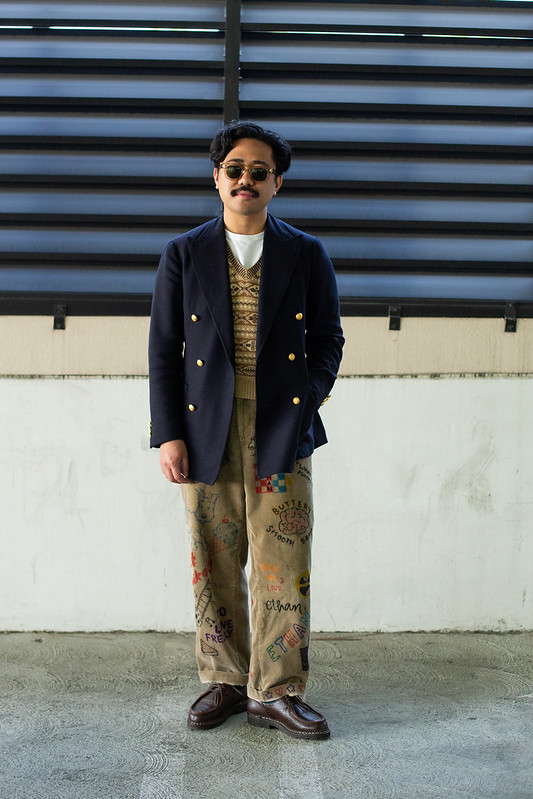
I realize that this might have been one of the most prescriptive things I’ve ever written and I try to shy away from this type of stuff! A lot of this was faux-philosophical talk and at the very least, not meant for a guy looking to not-be-naked. But that’s a bit of the point, right? ! All of this is the way of looking at this is determining your POV, or what you want to look like while you do your thing, and then putting it into actionable pieces through a foundational wardrobe. This is meant for people to find out what it is that excites them about clothes and be in a good spot to add new things when they do come up.
It may even help you realize that you’ve acquired everything essential for your style, which mitigates the purchase of new things. Yes, you can refrain from consuming when with a basic/capsule wardrobe, but that’s more pragmatic; most people I’ve met always found themselves wanting. When you know your foundations, you’re content because your clothes help you achieve some form of self-actualization. You’re good because your clothes are good.
After all, this whole thing presumes that the wearer’s definition of”good” is less about getting a girl’s number and more about the accuracy of self-expression. That’s why this concept is best used for people who are looking to develop their existing taste or at the every least, those who already use similar concepts in their work or other hobbies. It is true that most people I’ve met who follow the philosophy of a foundational wardrobe are people who have matured (or at least have high levels of intentionality) in their style. Foundations are meant to be more of a gut check and a framework for their existing approach to clothing. However, we do all agree that it would be great if people started from this mindset.
Granted, this whole thing is probably of no help to someone who has no clothes at all, which I honestly doubt exists unless you had a crazy emergency happen to you, in which case you should just follow any number of internet lists and come back to this when you feel comfortable. Again, most people will get along just fine with a plain tee shirt and jeans! But if you want more from your clothes than just getting along, then it will help to look at clothes as a foundation rather than a capsule meant to never change.
This approach isn’t for everyone and it probably doesn’t apply to most people’s contexts…though I firmly believe that’s false and I do think its entirely possible to be introspective, have fun, and wear what we want in our everyday lives.
It is funny though how much content there is around basic and capsule wardrobes. Haven’t we answered this “problem” with any of the iterations found across all menswear content? I wonder why this keeps happening…(the answer is because of sponsorships and affiliate links).

On a personal note, I’ve never actually followed these basic/capsule wardrobe lists. I got into menswear in pursuit of a very specific look. And when it comes to vintage, you can’t just buy basics whenever you want since you can only grab whatever is currently on eBay or in stock at your local vintage store. It took me years to get a summer-weight navy odd jacket because I just never came across any (at least not in my size)!
Sure, I may have followed the basics when I was buying stuff for college but starting out with the basics was never a part of my actual, intentional style. I only got basics (like a plain OCBD or a brass button blazer) after I realized I was missing them, which honestly shows how focused I was on aesthetics. I was fine getting dressed without them but it was my choice to start wearing them. I had to be seduced by basics and dressing in service of them.
I also figured out my foundational wardrobe by years of honing it. It was as tangible as possible, which meant I wore a fit everyday. I couldn’t imagine just asking AI to make me a wardrobe; it would be a disservice to make this into something dispassionate. I know that this reveals that a Foundational Wardrobe might be tough for guys starting out, but getting into this mindset from the beginning, focusing on your POV, and being introspective will definitely contribute to a more rewarding wardrobe that may contain bold pieces, but will be incredibly natural to wear. That should be the goal when building a wardrobe!
Anyway, this whole thing is the subject of the latest episode of Style & Direction. Spencer, MJ, and I discuss basic wardrobes as well as how we each approach the concept of the foundational wardrobe (spoiler, we all see it differently). A lot of the pod is about dissuading people from focusing on the traditional social benefits of basic wardrobes and how it’s better to be emotionally connected with your clothes instead of just being pragmatic. It’s not that a basic or capsule wardrobe isn’t useful, but outside from starting from scratch, it is better to develop your own taste and focus on what you like. In the end, even the basic/capsule wardrobe has a “look” to it and you need to decide if that’s specifically what you want to look like!
Podcast Outline
- 8:43 – Topic Start
- 17:38 – What is the Appeal of Capsule Wardrobes?
28:27 – Springboard Wardrobe and Basics - 47:29 – Our Foundational Wardrobes
- 1:25:04 – Wrap-up
Recommended Reading
- The Springboard Wardrobe written by Derek Guy on Put This On.
- Building a Wardrobe, from Permanent Style.
- The plethora of basic/capsule wardrobes on r/MaleFashionAdvice
- The Soul of Clothing by Marco. I always share his post, but it really gets at the core of what makes a foundational garment.
The Dress Like Ethan Basic/Capsule Wardrobe (aka things I would buy if I had to start over)
- DB suit in navy and dark brown
- SB suits in navy and dark brown
- spearpoint collar shirt in reverse blue stripe, white, and pink reverse stripe
- chambray workshirt
- tassel loafers in black and color 8
- black side zip boots
- brown cowboy boots
- white canvas deck shoes
- OCBD in blue uni stripe and plain white
- flared blue jeans (could also be a wide legged one)
- khaki and olive military chinos (m43 preferred)
- navy hopsack jacket (could be a blazer)
- brown checked jacket
- navy turtleneck
- sweater vests in navy and cream
- khaki gurkha shorts
- socks in white, navy, and purple
- grey crew neck sweater
- grey pleated trousers (flannel and summer weight)
- rayon sportshirts in black, brown, white, and 1-2 alohas
- thin western belts in black and dark brown
- navy kimono coat
- L.L bean sport vest or similar lapel-less jacket
- jungle jacket
- big raglan overcoat (navy, dark brown, or dark grey)
- pocket tees in navy, grey, and white
- black beret
- brown fedora (could also be a silverbelly)
- ties in black knit, solid navy, blue foulard, burgundy or brown foulard, red/blue repp, green striped repp,
- An open mind to try new things and expand



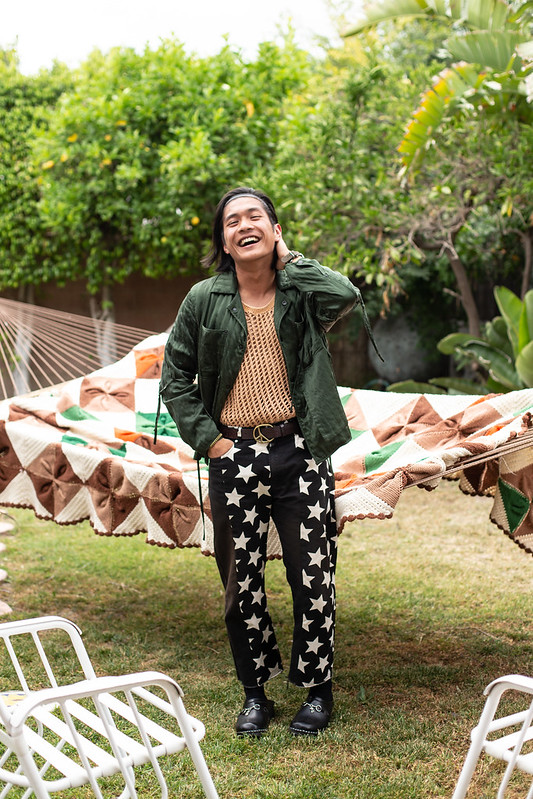



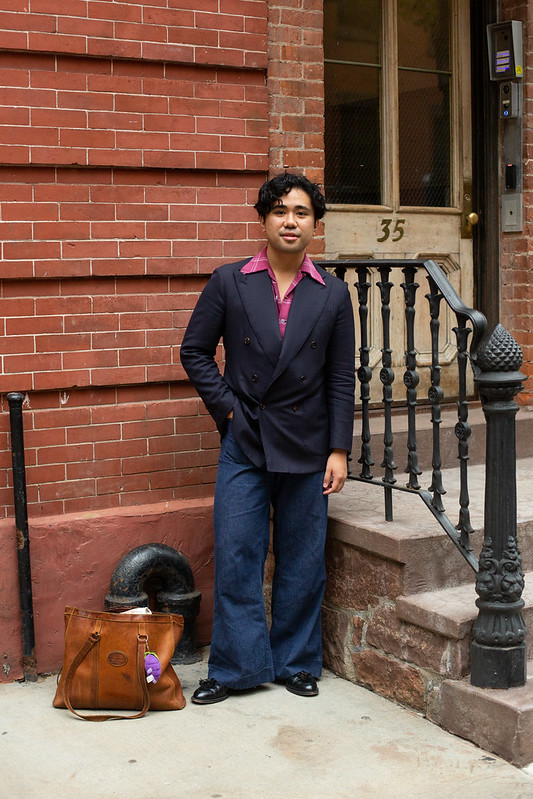



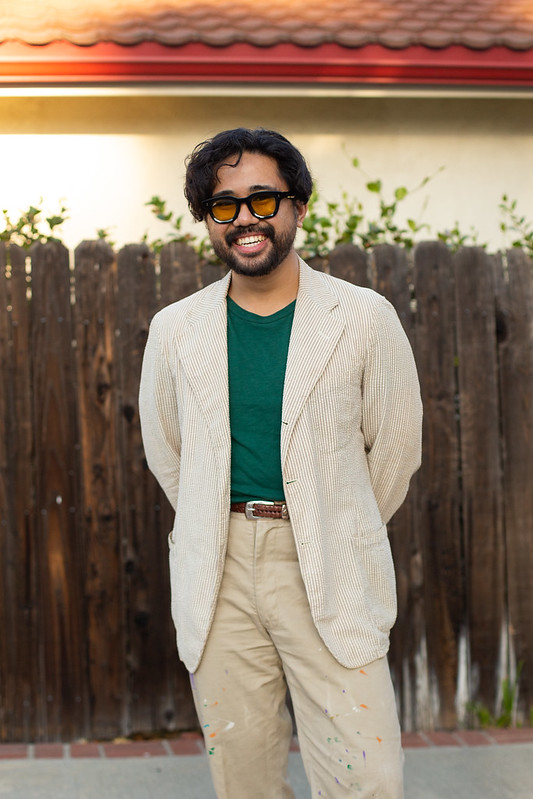


Thanks for listening and reading along! Don’t forget to support us on Patreon to get some extra content and access to our exclusive Discord.
The Podcast is produced by MJ.
Always a pleasure,
Big thank you to our top tier Patrons (the SaDCast Fanatics): Austin, Philip, Shane, Jarek, Henrik , and Alexander.
Thanks for reading! Don’t forget that you can support me (or the podcast) on Patreon to get some extra content and access to our exclusive Discord.
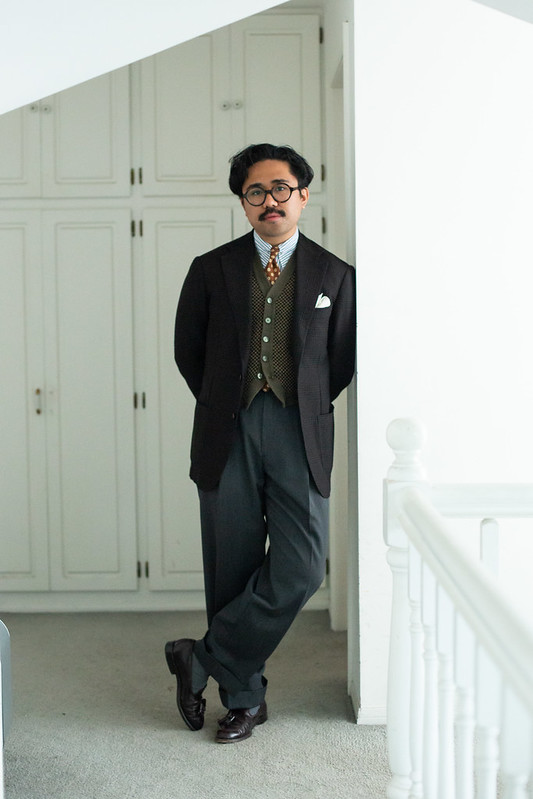
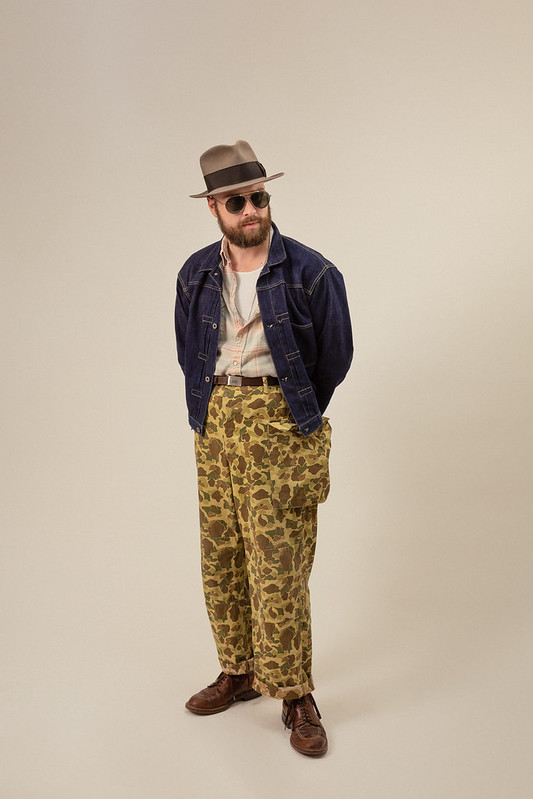


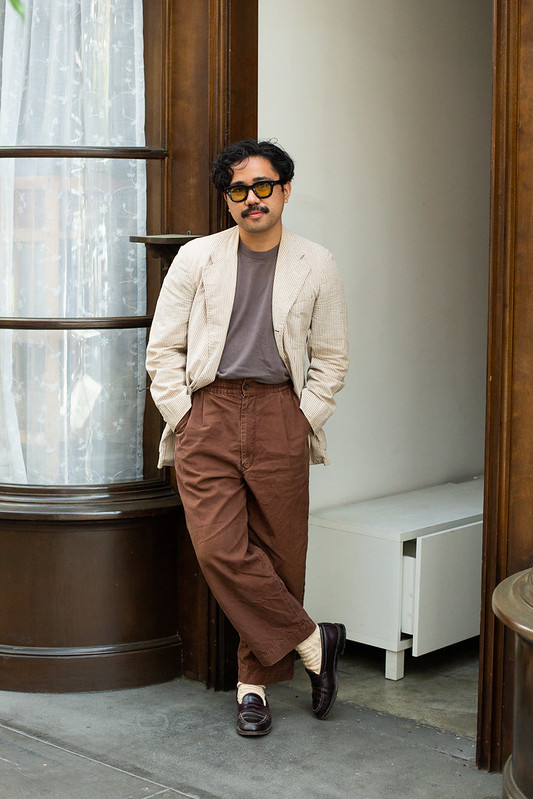
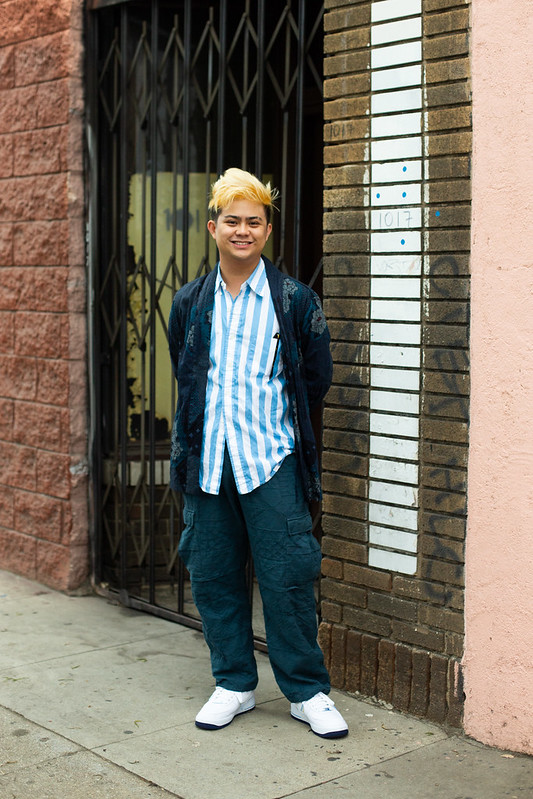
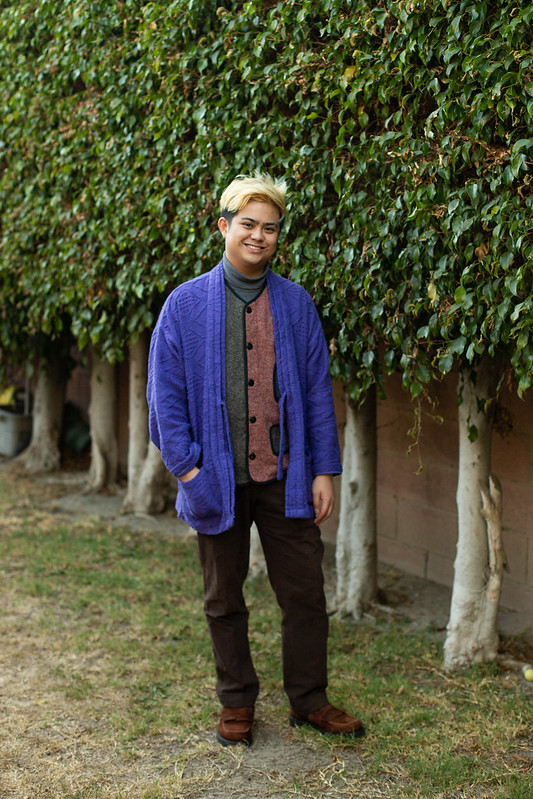
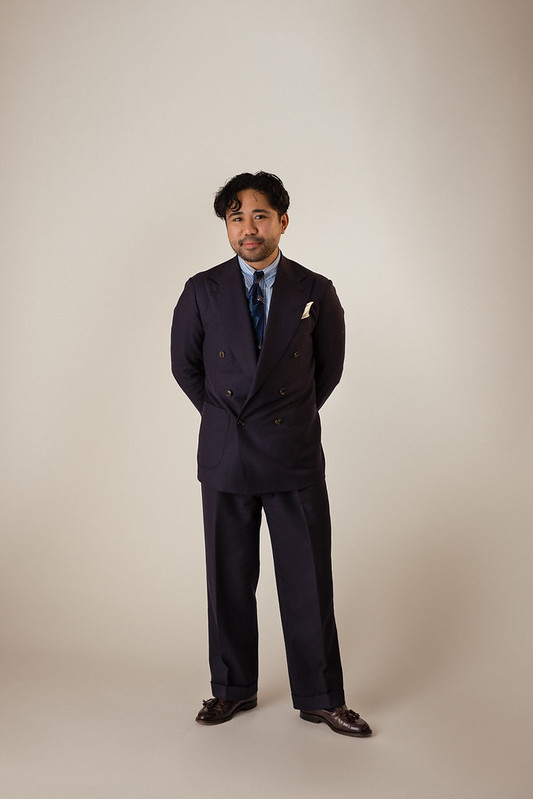

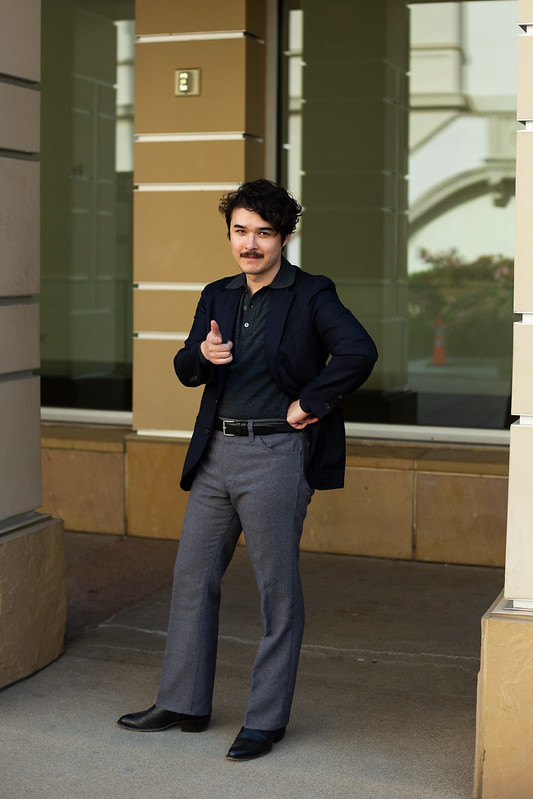
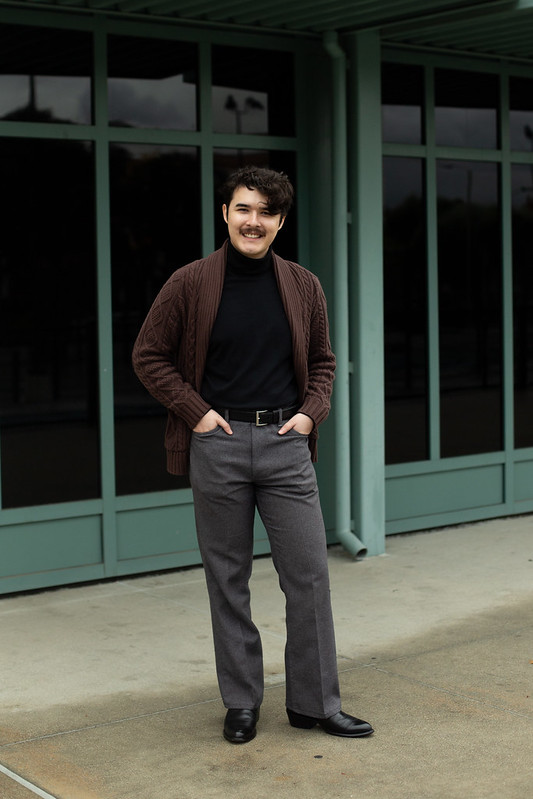


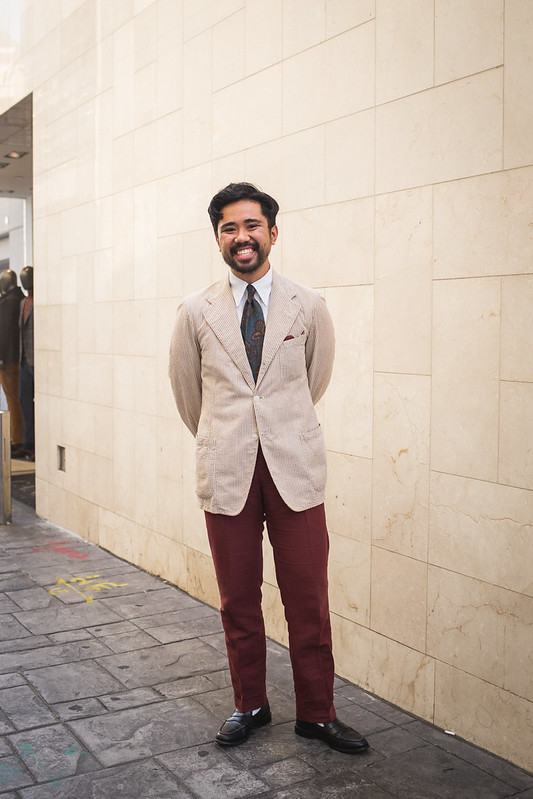
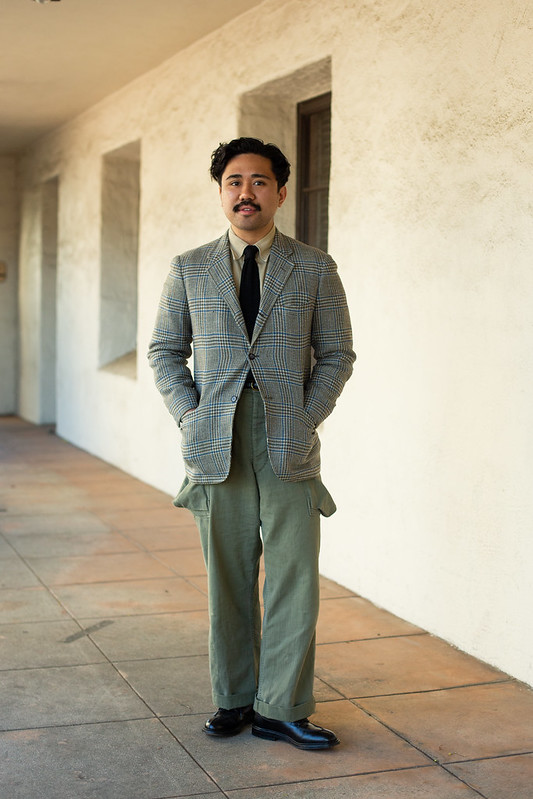
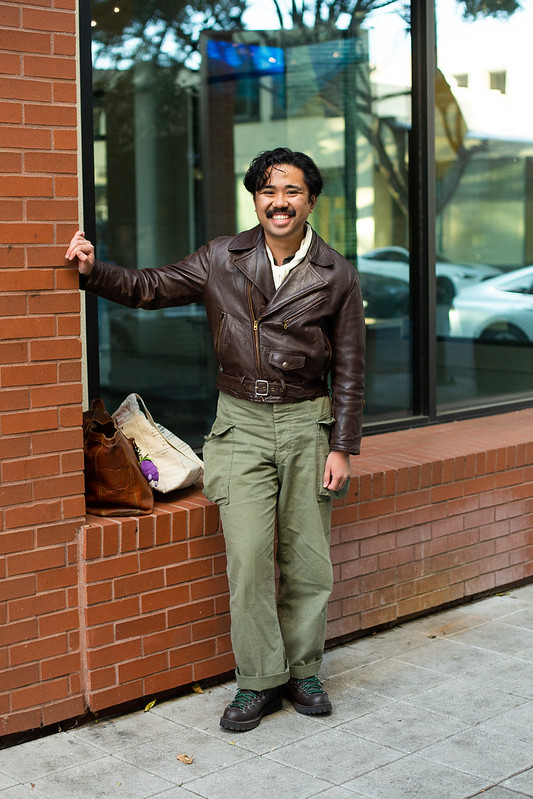




what does it mean when it says “tassel loafers in color 8”
LikeLike
“Color 8” is the shade of material (shell cordovan) of the loafers! It’s a specific name, rather than burgundy or brownish-purple.
LikeLike
The reference is to the Horween colour for their cordovan leather.
It is a reddish-dark borwn.
LikeLiked by 1 person
I agree with you Ethan, that the concept of a capsule wardrobe ill fits someone who actually enjoys clothing.
What I’ve found more useful is to suggest a sort of hierarchy of usefulness of certaing armetns (within an aesthetic).
LikeLike
That’s true! With something like Ivy or workwear, there are definitely items that are specifically best suited for a look. I guess what I’ve discovered is that we take foundational items from those genres and find out what is most applicable to us! sometimes it leans further into one aesthetic and sometimes its more eclectic!
LikeLike
Absolutely love this article! It took me a while to settle on a foundational wardrobe, and this article would have helped a lot when I was younger. The basic bastard never sit right with me, and in retrospect I actually dressed WORSE for a period after getting into fashion.
Now my foundational pieces are biiiiig pants and shorts with pleats, close fitted knit polos in the summer, knit and gauze sports shirts, and lots of chunky sweaters/cardigans in the winter. Chelsea boots, white sneakers, and fancy sandals that look like something a gladiator would wear haha.
LikeLike